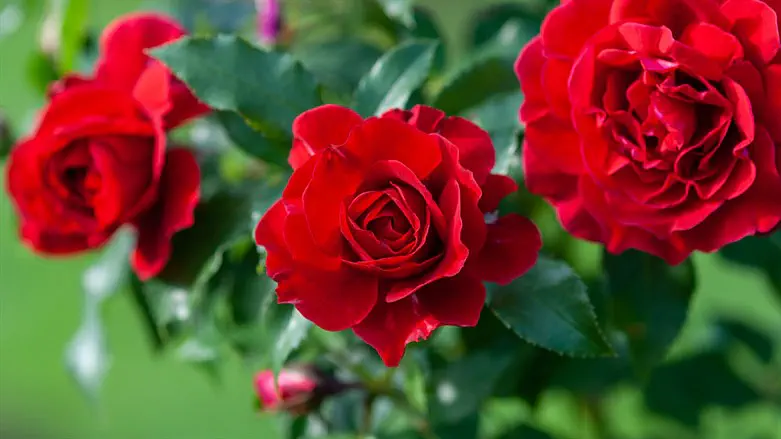
Israel is a country that boasts a diverse range of flora and fauna. Flowers play a significant role in Israeli culture and are an integral part of the country's natural beauty. The country's unique geography and climate make it an ideal place for a wide variety of flowers to grow and thrive. In this article, we will explore the different types of flowers that bloom in Israel and the seasons in which they bloom.
Israel has a Mediterranean climate, which means that it experiences hot, dry summers and cool, wet winters. This type of climate is perfect for the growth of various types of flowers, including both native and imported species. The country is also home to a wide range of plant life, from desert flora to lush forests.
One of the most famous flowers in Israel is the anemone. This flower is also known as the "Calaniot" in Hebrew, and it blooms in the winter months. The anemone is a popular symbol of Israel and is featured on many postcards and souvenirs. The anemone is a delicate flower that comes in a range of colors, including red, pink, and purple.
Another popular flower in Israel is the poppy. The poppy is a beautiful flower that grows in many different parts of the world, but it is particularly abundant in Israel. Poppies typically bloom in the spring and early summer, and they come in a range of colors, including red, orange, and yellow.
The wild iris is another flower that is commonly found in Israel. This flower blooms in the spring and comes in a variety of colors, including purple, blue, and white. The wild iris is a beautiful flower that is often used in traditional Jewish ceremonies.
The almond blossom is another flower that is synonymous with Israel. The almond tree is native to the Middle East and is one of the earliest trees to bloom in the spring. The almond blossom is a beautiful pinkish-white flower that covers the tree's branches, creating a stunning sight. The almond blossom is also a symbol of the renewal of life and hope.
Cyclamen is another flower that is found in Israel. This flower blooms in the fall and winter and comes in a range of colors, including pink, red, and white. The cyclamen is a beautiful flower that is often used in landscaping and is also used in traditional Jewish ceremonies.
The oleander is another popular flower in Israel. This flower blooms in the summer and comes in a range of colors, including pink, white, and red. The oleander is a common sight in Israeli gardens and is often used as a hedge or a border plant.
The trumpet lily is another flower that is found in Israel. This flower blooms in the summer and comes in a range of colors, including pink, yellow, and orange. The trumpet lily is a beautiful flower that is often used in landscaping and is also used in traditional Jewish ceremonies.
The bougainvillea is another flower that is commonly found in Israel. This flower blooms in the summer and comes in a range of colors, including pink, purple, and red. The bougainvillea is a hardy plant that is often used in landscaping and can be seen growing along the sides of buildings and in public spaces.
In addition to these flowers, Israel is also home to many other types of plant life, including cacti, succulents, and wildflowers. The country's diverse range of flora and fauna is a testament to its unique geography and climate.
In terms of seasons, the flowers in Israel bloom at different times of the year depending on the climate and the location. As mentioned earlier, the anemone blooms in the winter, while the poppy blooms in the spring and early summer. The wild iris, cyclamen, and almond blossom all bloom in the spring, while the trumpet lily, bougainvillea, and oleander all bloom in the summer.
In the desert regions of Israel, there are also many types of cacti and succulents that bloom throughout the year. These plants are adapted to the harsh desert environment and can survive in hot, dry conditions with little water.
In addition to their natural beauty, flowers also play an important role in Israeli culture and tradition. Flowers are used in many Jewish ceremonies and holidays, such as weddings, funerals, and Shabbat. Flowers are also often used to decorate homes and public spaces during festivals and celebrations, such as Passover and Hanukkah.
Aside from their beauty and cultural significance, flowers also have important ecological roles in Israel. They provide food and habitat for many types of insects and animals, including bees, butterflies, and hummingbirds. Pollinators are essential for the reproduction of many plant species, and without them, many of the flowers in Israel would not be able to survive.
In recent years, there has been growing concern about the decline of pollinators worldwide, including in Israel. The use of pesticides, habitat loss, and climate change are just a few of the factors that are contributing to this decline. As a result, many conservation efforts are underway to protect and restore pollinator habitats in Israel.
One such initiative is the creation of pollinator gardens. These gardens are designed to provide food and habitat for pollinators and other wildlife. They often feature a variety of native plant species that are well-suited to the local climate and soil conditions. By creating these gardens, communities and individuals can help support pollinators and promote biodiversity in their local area.
Another important initiative in Israel is the conservation of wildflower habitats. Many of the country's wildflower habitats have been destroyed or degraded over time, leading to the loss of many plant species and the animals that depend on them. Conservation efforts aim to protect these habitats and restore them to their natural state, ensuring that future generations can enjoy the beauty and ecological benefits of these areas.
Overall, the flowers of Israel are an important part of the country's natural heritage and cultural identity. From the iconic anemone to the beautiful almond blossom, each flower has its unique story and significance. Whether you are a local or a visitor, taking the time to appreciate the beauty and ecological importance of these flowers can help foster a deeper connection to the natural world and the importance of conservation efforts.
If you are planning a trip to Israel, there are many places to see the country's stunning flowers in their natural habitat. Here are some of the best spots to see flowers in Israel:
Mount Meron - Located in northern Israel, Mount Meron is known for its diverse range of plant life, including many types of wildflowers. In the spring, the mountain is covered in a colorful carpet of flowers, making it a popular destination for hikers and nature enthusiasts. Ein Gedi Nature Reserve - This desert oasis is home to a variety of plant species, including many types of cacti and succulents. The reserve is also known for its waterfalls, streams, and pools, which provide important habitats for many types of wildlife. Jerusalem Botanical Gardens - This 120-acre garden features a wide range of plant species from around the world, as well as many native Israeli plants. The gardens are home to a variety of flowering plants, including the iconic anemone and almond blossom. Hula Valley - This wetland area in northern Israel is home to a wide range of plant and animal species, including many types of waterfowl. The valley is also known for its wildflowers, which bloom in the spring and early summer. Carmel Mountains - Located in northern Israel, the Carmel Mountains are known for their diverse range of plant species, including many types of wildflowers. The mountains offer stunning views of the surrounding landscape and are a popular destination for hikers and nature lovers.
In conclusion, the flowers of Israel are an important part of the country's natural beauty, cultural identity, and ecological diversity. Whether you are a local or a visitor, taking the time to appreciate and learn about these flowers can help foster a deeper connection to the natural world and the importance of conservation efforts. With their unique stories and significance, the flowers of Israel are truly a sight to behold.
